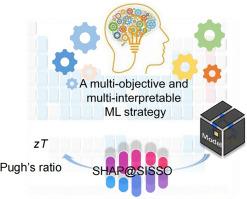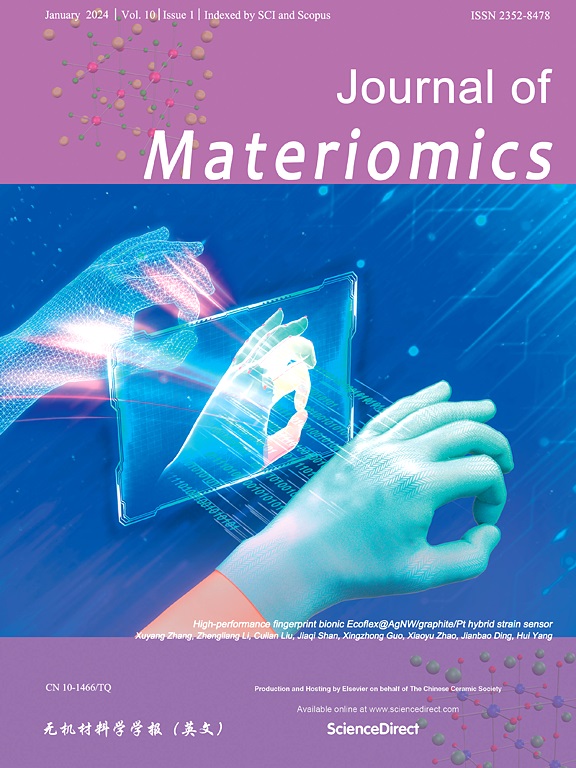通过领域知识验证韧性热电材料的多目标、多解释机器学习演示
IF 8.4
1区 材料科学
Q1 CHEMISTRY, PHYSICAL
引用次数: 0
摘要
多目标机器学习(ML)方法被广泛应用于材料领域,因为材料优化总是多目标的。传统的多目标优化方法主要采用分层单目标优化组合。然而,这种策略往往难以找到能同时优化多个目标的特征。本文以延展性和热电性能两个目标为例,采用可解释、可说明的多目标优化策略,寻找可同时优化多个目标的特征。具体来说,SHAP 和 SISSO 用于关键特征与目标值之间的定性分析和定量分析。SISSO 和 SHAP 均表明,EN(ab)A/B 和 V 均与 zT 正相关,而与 Pugh's ratio 负相关。此外,领域知识也有助于合理解释这两个有利特征。EN(ab)A/B较大的化合物往往具有较高的带变性,从而导致较高的zT。高 EN(ab)A/B 相当于弱 B-X 键,从而降低了 G 和普氏比,提高了材料的延展性。另一方面,大 V 会导致小 G,有利于小普氏比和大 zT(通过低 κL)。本研究表明了多目标优化和领域知识在材料信息学发展中的重要意义。本文章由计算机程序翻译,如有差异,请以英文原文为准。

A multi-objective, multi-interpretable machine learning demonstration verified by domain knowledge for ductile thermoelectric materials
Multi-objective machine learning (ML) methods are widely used in the field of materials because material optimizations are always multi-objective. Traditional multi-objective optimization methods mainly use a combination of hierarchical single-objective optimization. However, this strategy often has difficulty in finding features that can optimize multiple objectives simultaneously. In this work, taking the two objectives of ductility and thermoelectric performance as examples, interpretable and explainable ML strategies are used to find features that can simultaneously optimize multiple objectives. Specifically, SHAP and SISSO are applied for qualitative analysis and quantitative analysis between key features and target values. Both SISSO and SHAP show that EN(ab)A/B and V are both positively correlated with zT and negatively correlated with Pugh's ratio. Furthermore, domain knowledge helps to rationalize the two favorable features. The compounds with large EN(ab)A/B tend to have high band degeneracies, resulting in high zT. High EN(ab)A/B correspond to weak B–X bonds, reducing the G and Pugh's ratio, and improving the ductility of materials. On the other hand, large V will cause small G, which is beneficial to small Pugh's ratio and large zT (via low κL). The present work demonstrates the significance of multi-objective optimization and domain knowledge in the development of materials informatics.
求助全文
通过发布文献求助,成功后即可免费获取论文全文。
去求助
来源期刊

Journal of Materiomics
Materials Science-Metals and Alloys
CiteScore
14.30
自引率
6.40%
发文量
331
审稿时长
37 days
期刊介绍:
The Journal of Materiomics is a peer-reviewed open-access journal that aims to serve as a forum for the continuous dissemination of research within the field of materials science. It particularly emphasizes systematic studies on the relationships between composition, processing, structure, property, and performance of advanced materials. The journal is supported by the Chinese Ceramic Society and is indexed in SCIE and Scopus. It is commonly referred to as J Materiomics.
 求助内容:
求助内容: 应助结果提醒方式:
应助结果提醒方式:


